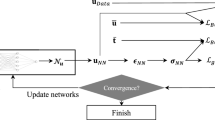Abstract
A new approach for data assimilation, which is based on the adjoint method, but allows the computer code for the adjoint to be constructed directly from the model computer code, is described. This technique is straightforward and reduces the chance of introducing errors in the construction of the adjoint code. Implementation of the technique is illustrated by applying it to a simple predator-prey model in a model fitting mode. A series of identical twin numerical experiments are used to show that this data assimilation approach can successfully recover model parameters as well as initial conditions. However, the ease with which these values are recovered is dependent on the form of the model equations as well as on the type and amount of data that are available. Additional numerical experiments show that sufficient coefficient and parameter recoveries are possible even when the assimilated data contain significant random noise. Thus, for biological systems that can be described by ecosystem models, the adjoint method represents a powerful approach for estimating values for little-known biological parameters, such as initial conditions, growth rates, and mortality rates.
Similar content being viewed by others
References
Abbott, M. R. 1992. Report of the U.S., JGOFS workshop on modeling and data assimilation. U.S. JGOFS Planning Report Number 14, 28 pp.
Bengtsson, L., M. Ghil and E. Källén (Eds). 1981.Dynamic Meteorology: Data Assimilation Methods. New York: Springer.
Bratseth, A. M. 1986. Statistical interpolation by means of successive corrections.Tellus 38A, 439–447.
Courtier, P. and O. Talagrand. 1986. Variational assimilation of meteorological observations with the adjoint vorticity equation, II. Numerical results.Q. J. R. met. Soc. 113, 1329–1347.
Cressman, G. P. 1959. An operational objective analysis system.Mon. Wea. Rev. 87, 367–374.
Derber, J. C. 1985. The variational four-dimensional assimilation of analyses using filtered models as constraints. Ph.D. dissertation, 142 pp. Univ. of Wisconsin, Madison, Wisconsin.
Dickey, T. D. 1991. The emergence of concurrent high-resolution physical and bio-optical measurements in the upper ocean and their applications.Rev. Geophys. 29, 383–413.
Gandin, L. S. 1963.Objective Analysis of Meteorological Fields. (From the Russian) Israel program for Scientific Translations, 1965, Jerusalem, 242 pp.
Ghil, M. and P. Malanotte-Rizzoli. 1991. Data assimilation in meteorology and oceanography.Adv. Geophys. 33, 141–266.
Ghil, P. E., W. Murray and M. H. Wright. 1981.Practical Optimization. Orlando: Academic Press.
Giering, R. 1992.Adjoint Model Compiler. Max-Planck-Institute für Meterologie.
Giering, R. 1995. Adjoint code generation. Max-Planck-Institute für Meterologie, in preparation.
Gilbert, J. C. and C. Lemaréchal. 1989. Some numerical experiments with variable-storage quasi-Newton algorithms.Math. Prog. 45, 405–435.
GLOBEC. 1991. Theory and modeling in GLOBEC: a first step. U.S. GLOBEC Report Number 1, 9 pp.
Haidvogel, D. B. and A. R. Robinson (Eds). 1989. Special issue: data assimilation.Dyn. Atmos. Oceans 13, 171–513.
Ishizaka, J. 1990. Coupling of Coastal Zone Color Scanner data to a physical-biological model of the southeastern U.S. continental shelf ecosystem—3. Nutrient and phytoplankton fluxes and CZCS data assimilation.J. geophys. Res. 95, 20, 167–20, 181.
Ishizaka, J. 1993. Data assimilation for biogeochemical models. InTowards a Model of Ocean Biogeochemical Processes. G. T. Evans and M. J. R. Fasham (Eds), pp. 295–316. New York: Springer.
Ishizaka, J. and E. E. Hofmann. 1993. Coupling of ocean color data to physical-biological models. InOcean Colour: Theory and Applications in a Decade of CZCS Experience. V. Barale and P. M. Schlittenhardt (Eds), pp. 271–288. ECSC, EEC, EAEC, The Netherlands.
Kalman, R. E. 1960. A new approach to linear filtering and prediction problems.J. Basic Engng (Transactions of the ASME) 82D, 35–45.
Kalman, R. E. and R. S. Bucy. 1961. New results in linear filtering and prediction theory.J. Basic Engng (Transactions of the ASME) 83D, 95–108.
Le Dimet, F. X. and O. Talagrand. 1986. Variational algorithms for analysis and assimilation of meterological observations: theoretical aspects.Tellus, Ser. A 38, 97–110.
Lewis, J. M. and J. C. Derber. 1985. The use of adjoint equations to solve a variational adjustment problem with adjective constraints.Tellus, Ser. A 38, 309–322.
Long, R. B. and W. C. Thacker. 1989a. Data assimilation into a numerical equatorial ocean model, Part I: the model and the assimilation algorithm.Dyn. Atmos. Oceans 13, 379–412.
Long, R. B. and W. C. Thacker. 1989b. Data assimilation into a numerical equatorial ocean model, Part II: assimilation experiments.Dyn. Atmos. Oceans 13, 413–440.
Lorenc, A. C. 1981. A global three-dimensional multivariate statistical interpolation scheme.Mon. Wa. Rev. 109, 701–721.
Lorenc, A. C. 1986. Analysis methods for numerical weather prediction.Q. J. R. met. Soc. 112, 1177–1194.
Lorenc, A. C. 1988a. Optimal non-linear objective analysis.Q. J. R. met. Soc. 114, 205–240.
Lorenc, A. C. 1988b. A practical approximation to optimal 4-dimensional objective analysis.Mon. Wea. Rev. 116, 730–745.
Navon, I. M. 1986. A review of variational and optimization methods in meteorology. InVariational Methods in Geosciences, Y. Sasaki (Ed.), pp. 29–34. New York: Elsevier.
Nocedal, J. 1980. Updating quasi-Newton matrices with limited storage.Math. Comput. 35/151. 773–782.
Talagrand, O. 1991. The use of adjoint equations in numerical modeling of the atmospheric circulation. InAutomatic Differentiation of Algorithms: Theory, Implementation and Application, A. Griewank and G. Corliess (Eds), pp. 169–180. SIAM.
Talagrand, O. and P. Courtier. 1987. Variational assimilation of meteorological observations with the adjoint vorticity equation, I, theory.Q. J. R. met. Soc. 113, 1311–1328.
Thacker, W. C. 1987. Three lectures on fitting numerical models to observations. External Rep., GKSS 87/E/65, GKSS Forschungszentrum Geesthacht, Geesthacht.
Thacker, W. C. and R. B. Long. 1988. Fitting dynamics to data.J. geophys. Res. 93, 1227–1240.
Yoder, J. A., W. E. Esaias, G. C. Feldman and C. R. McClain. 1988. Satellite ocean color-status report.Oceanography 1, 18–20.
Zou, X., I. M. Navon, M. Berger, K. H. Phua, T. Schlick and F. X. Le Dimet 1993. Numerical experience with limited-memory quasi-Newton and truncated Newton methods.SIAM J. Optim. 3, 582–608.
Author information
Authors and Affiliations
Rights and permissions
About this article
Cite this article
Lawson, L.M., Spitz, Y.H., Hofmann, E.E. et al. A data assimilation technique applied to a predator-prey model. Bltn Mathcal Biology 57, 593–617 (1995). https://doi.org/10.1007/BF02460785
Received:
Accepted:
Issue Date:
DOI: https://doi.org/10.1007/BF02460785




